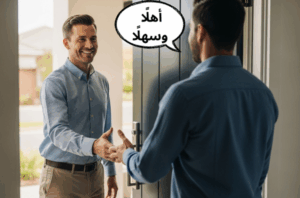Arabic is a rich and complex language, known for its unique grammar and intricate word structures. One of the fascinating aspects of Arabic is its plural formation, which varies between Modern Standard Arabic (MSA) and diverse colloquial dialects spoken across the Arab world. However, despite regional differences, there are many commonalities in how plurals are formed. Notably, in Arabic, the plural form is used to express more than two, as there is a distinct rule for referring to exactly two objects or people, known as the dual form. This article will explore these commonalities, followed by specific grammatical differences in MSA and colloquial Arabic.
Basic plural formation in Arabic In Arabic, there are two types of plurals: broken plurals and sound plurals. The difference between them is that sound plurals follow a fixed pattern, which we will learn below, while broken plurals do not follow a fixed pattern and must simply be memorized.
Unfortunately, determining whether a noun or adjective can be pluralized using a sound or broken plural is also random and must be memorized. You can recognize this through practice and repetition.
We apologize for the amount of memorization required in this paragraph, but constant exposure to Arabic through real-world videos on Playaling will make it easier.
Plural formation in Arabic Plural formation in both Arabic dialects and Modern Standard Arabic is done in a similar manner with some differences.
Commonalities in plural formation Regular (sound) plurals are formed by adding specific endings to the singular form of the noun. These can be further divided into regular masculine and feminine plurals.
Masculine sound plurals Formed by adding ين
to the end of the singular masculine noun.
Examples:
You can see how this rule applies to all types of Arabic, like Standard, Levantine , Egyptian , Gulf , and Darija with the difference often being in pronunciation according to each dialect:
English Singular masculine in MSA, Levantine, Egyptian, Gulf, and Darija MSA plural Levantine plural Egyptian plural Gulf plural Darija plural engineer مهندس
مهندسين
مهندسين
مهندسين
مهندسين
مهندسين
P.S.: Plural human nouns that take masculine form can refer to either a group of all men or a group of men and women.
Pay attention to the different plural forms of the nouns mentioned in this Lebanese clip. English Singular masculine in MSA, Levantine, Egyptian, and Gulf Singular masculine in Darija MSA plural Levantine plural Egyptian plural Gulf plural Darija plural gray رمادي
رمادي
رماديين
رماديين
رمادي
رماديين
رماديين
ready جاهز
واجد
جاهزين
جاهزين
جاهزين
جاهزين
واجدين
Feminine sound plurals Formed by replacing the ة
with ات
at the end of the singular feminine noun.
Examples:
English Singular masculine in MSA, Levantine, Egyptian, Gulf, and Darija MSA plural Levantine plural Egyptian plural Gulf plural Darija plural engineer مهندسة
مهندسات
مهندسات
مهندسات
مهندسات
مهندسات
English Singular masculine in MSA, Levantine and Gulf Singular masculine in Egyptian Singular masculine in Darija MSA plural Levantine plural Egyptian plural Gulf plural Darija plural gray رمادية
رمادي
رمادية
رماديات
رماديات
رمادي
رماديات
رماديات
ready جاهزة
جاهزة
واجدة
جاهزات
جاهزات
جاهزين
جاهزات
واجدات
A romantic clip from a series in Syrian Arabic .Broken plurals Broken plurals, or جمع التكسير
, do not follow a regular pattern and involve changes within the structure of the singular noun itself. These changes often include alterations to the vowels and sometimes the consonants.
Examples:
Palestinian students from Gaza talk about the difference between school and university books .English Singular masculine in MSA, Levantine, Egyptian, Gulf, and Darija MSA plural Levantine plural Egyptian plural Gulf plural Darija plural red أحمر
حمر
حمر
حمر
حمر
حومر
English Singular masculine in MSA, Levantine, Egyptian, and Gulf Singular masculine in Darija MSA plural Levantine plural Egyptian plural Gulf plural Darija plural kid طفل
طفل
أطفال
أطفال
أطفال
أطفال
أطفال
house بيت
دار
بيوت
بيوت
بيوت
بيوت
ديور
Notice how “cats” is pronounced in Moroccan Arabic. Specific grammatical differences Masculine sound plurals in MSA In Modern Standard Arabic, ون
or ين
is added to form the masculine sound plural, depending on the position of the word in the sentence. However, for beginners, adding either suffix will be understood as a plural. Don’t worry.
Example:
رمادي
(gray) becomes رماديون
(gray) or رماديين
.
Broken plurals In some dialects, colloquial plurals can take unique forms that differ from MSA:
English Singular masculine in MSA Singular masculine in Levantine and Gulf Singular masculine in Egyptian Singular masculine in Darija MSA plural Levantine plural Egyptian plural Gulf plural Darija plural woman امرأة
مرا
حرمة
مرأة
نساء
نسوان
نسوان
نسوان
نسوان
man رجل
رجّال
راجل
راجل
رجال
رجال
رجالة
رجال
رجال
rug سجادة
سجادة
سجادة
زربية
سجاد
سجاد
سجاد
سجاجيد
زرابي
book كتاب
كتاب
كتاب
كتاب
كتب
كتب
كتب
كتب
كتوبة
kid ولد
ولد
ولد
دريات
أولاد
ولاد
أولاد
ولاد
دراري
Dialect-specific plural rules Levantine & Gulf In the Levantine & Gulf dialects, plural formation follows specific patterns:
The suffix ين
:
is added to the end of masculine nouns and adjectives in the sound plural.
Examples: معلم
(teacher) becomes معلمين
(teachers), فنان
(artist) becomes فنانين
(artists)
The suffix ات
:
is added to the feminine nouns and adjectives in the sound plural.
Examples: معلمة
(female teacher) becomes معلمات
(female teachers), سيارة
(car) becomes سيارات
(cars)
For broken plurals:
specific forms must be memorized.
Adjectives for animals and inanimate objects:
can use either the plural or the singular feminine form.
Examples: الكتب الزرقا
or الكتب الزرق
(the blue books)
For describing people:
the plural form is used except for الناس
(people), which can use the singular feminine or plural form.
Examples: الناس الحلوة
or الناس الحلوين
The suffix ية
:
Used for borrowed nouns or professions.
Examples: سكرتير
(secretary) becomes سكرتيرية
(secretaries)
Inanimate nouns , including those borrowed from other languages, typically pluralize with ات
, regardless of their original gender, such as تليفونات
(telephones) and باصات
(buses)
Note the plural of mall (مول) in Jordanian Arabic . Egyptian dialect The Egyptian dialect has its rules for plural formation:
No standard plural for color names:
For colors derived from materials or objects, the suffix ـي
is typically added to form the adjective, and this form remains consistent across masculine, feminine, and plural forms.
Examples: برتقاني
(orange), دهبي
(gold), فضي
(silver), كحلي
(navy blue)
In Egyptian Arabic, colors do not typically take a regular plural form.
Note: The rule about colors derived from materials or objects is common across Arabic dialects. However, what is unique to the Egyptian dialect is the absence of a distinct feminine form, even in the singular. These adjectives stay the same regardless of gender or number.
Inanimate plural nouns are modified by feminine singular adjectives.
Examples: الكتب القديمة
(the old books), العربيات الجديدة
(the new cars)
Animate plural nouns are modified by masculine plural adjectives.
Example: البنات جاهزين
(the girls are ready)
Animals plural nouns are modified by feminine singular adjectives.
Example: الكلاب جاهزة
(the dogs are ready)
Maghrebi dialect In the Maghrebi dialect, plural formation can have unique forms not found in MSA or other dialects. Specific rules must be memorized, and regional variations influence pronunciation and usage.
The suffix ين
:
Is added to the end of masculine nouns and adjectives in the sound plural.
Examples: واجدين
(ready, pl), مهندسين
(engineers)
The suffix ات
:
Is added to to the end of feminine nouns and adjectives in the sound plural.
Examples: مهندسات
engineers(feminine plural), واجدات
ready (feminine plural)
There are irregular cases in Darija for the plural and must be memorized for example, it’s different than MSA in most cases: كتوبة
(books), قرودة
(monkies), قطوط
(cats)Adjectives for animals and inanimate objects can use either the plural or the singular feminine form.
الكتوبة الزرقة
(the blue books) or الكُتوبة الزورق
القطوط البرتقالية
or القطوط البرتقاليين
(the orange cats)
For describing people, the plural form is used except for الناس
word (people) , which can use the singular masculine or plural form.
Understanding plural formation in Arabic requires recognizing both the common rules shared across MSA and colloquial dialects, as well as the specific variations unique to each form. While MSA maintains consistent grammatical structures, colloquial dialects offer a rich diversity of plural forms. By appreciating these nuances, learners can better navigate the complexities of Arabic plurals, whether in formal writing or everyday conversation.
Oh, and by the way… If learning Arabic at your own pace, with fun, real-world videos sounds like your style, then Playaling could be exactly what you’re looking for!
With Playaling, you’ll dive into any major Arabic dialect or MSA. Our diverse range of videos has it all—from everyday conversations and cultural moments to music videos, TV and movie clips, influencer content, news broadcasts, and inspiring talks.
Our interactive captions let you tap any word for instant translations, context, and audio. So, real Arabic content becomes accessible with just a click. Miss something? No problem—rewind and listen as often as you need, or hover over subtitles for quick definitions.
Spot a word you want to learn? Save it to your personalized word set, or dive into curated sets for focused practice and easy review.
Interactive exercises let you dive in and practice what you’ve learned.
Need to look something up? The Audio Dictionary has you covered with clear human pronunciations and real world examples.
It’s a learning experience that keeps you engaged, bringing authentic, real-world Arabic closer to you every step of the way.
Give it a try!









